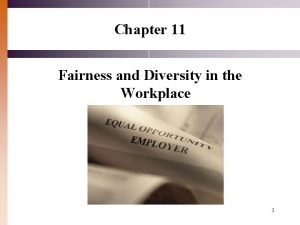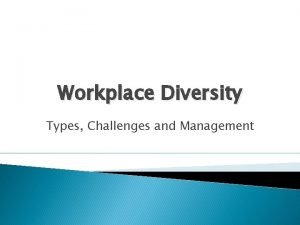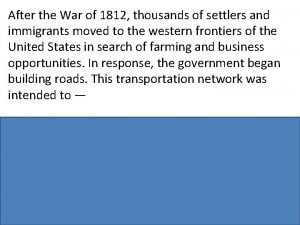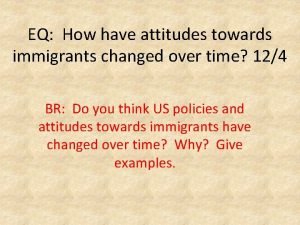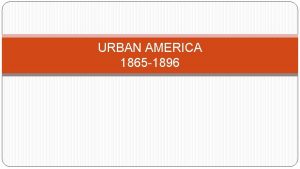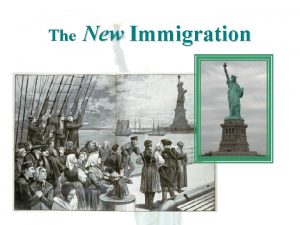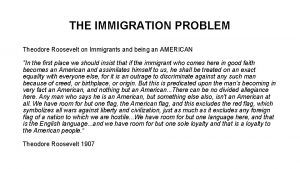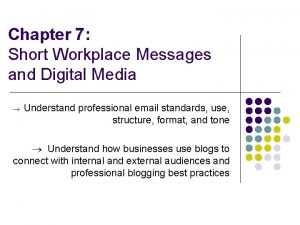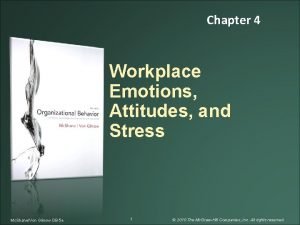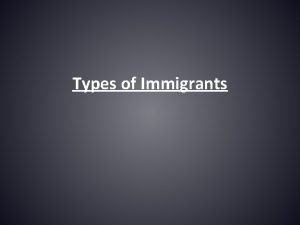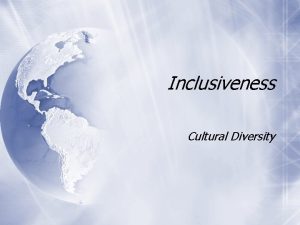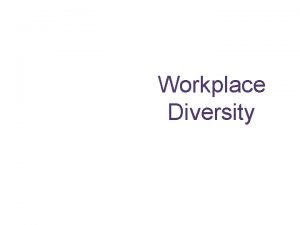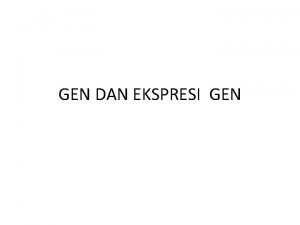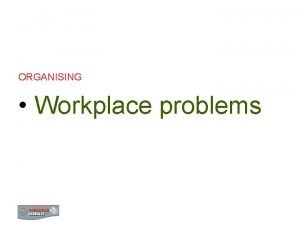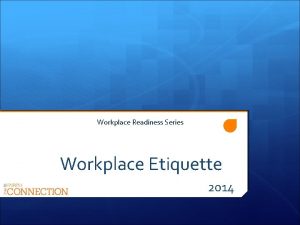Workplace Diversity and Inclusiveness Diversity Immigrants Gen Y





























- Slides: 29

Workplace Diversity and Inclusiveness Diversity, Immigrants, Gen Y and New Technologies Wendy Cukier MA, MBA, Ph. D, DU (hon), LLD (hon), M. S. C. Associate Dean, Business Founder, The Diversity Institute Ryerson University

AGENDA 1. The Business Case for Diversity 2. Effecting Change q - Organizational Strategies q - Social Innovation and Change q - Personal Strategies 22

WHAT IS DIVERSITY? “All forms of individual differences, including race, ethnicity, culture, gender, age, marital status, religious beliefs, educational background, stage in career, physical and mental ability, personality, social status and sexual orientation” Effective management of diversity promotes a fair and equitable work place and is critical to organizational performance 33 3

Under-representation persists • Immigrants are under-employed in Canada. § Earn 85% of Canadian born in spite of having higher levels of education § Face barriers to career advancement • Visible minorities were 16% of the population in 2006 § Only 44% of corporate boards had at least 1 visible minority director § In 2006, 7. 8% of all Members of Parliament were visible minorities 44

Gender wage gap persists In 1980 women earned 60. 2% of men’s wages Now women earn 81% of men’s wages BUT in Canada visible minority women earn 64% and Aboriginal women earn 46% of men’s wages 55

Representation of Leaders (DI and Maytree, 2009) • GTA - 49. 5 % visible minorities • Just 13% of 3257 leaders were visible minorities • Education sector was the most diverse, and the corporate sector least • Overall, women represented 38% of leaders • Similar pattern; women best represented in education sector (59%) and least in corporate sector (15%) 66 6

The “Glass Ceiling” Persists 77

Women are under-represented in technology 88

The Business Case? 1. Addressing the Labour Shortage • • • 99 Aging population = critical skill shortages By the year 2011, 100% of workforce growth in Canada will be fuelled by immigration Higher percentage of immigrants are visible minorities Changing generational values regarding work-life Our ability to integrate immigrants is critical to business success and national competitiveness

2. Enhancing employee productivity • • 10 10 There are significant gaps in the satisfaction of mid career visible minority versus white employees in large Canadian firms (Yap, 2008) 36% of gay employees will change careers in the face of discrimination (Stonewall, 2008) Career satisfaction is linked to retention, loyalty, retention and productivity Gen Y’s have different values, motivations and tools

3. Growing diversity of markets • • • 11 11 11 Markets are increasingly diversified - immigrant advantage Women buy cars and drink beer “Pink Dollar” is worth $75 billion per year in Canada Technology use is changing: social media (web 2. 0) revolution Matching diversity of workforce to diversity of markets provides an advantage

4. Harnessing Diversity = Innovation • Diversity and creativity are linked • “Innovation comes from a deep understanding of customers not just R&D spending” – Booz Allen • “Creative City” - Richard Florida et. al. • Multiple perspectives provide better solutions 12 12

5. Risk Avoidance • Recent Ontario Human Rights cases relate to GLBT issues • Pay equity decisions • Lawsuits • Negative effects on REPUTATION 13 13

BARRIERS: FOCUS ON ORGANIZATIONS Individual Group Organization Sector Social Environment • “Hidden” Job Market and Exclusion from informal networks • Language and “communication” norms concerning “self promotion” • Lack of recognition of international credentials • Catch 22: No Canadian experience • Access to Mentors and Role Models • Stereotypes of leadership eg. “Think Manager, Think Male” • Boomer styles of work and management: workaholic culture • Multiple Roles : 25% male CEOs have partners working outside the home compared to 75% of female CEOs 14 14

Chilly Climate? (DI and Catalyst, 2007) White/Caucasian Respondents Survey Items: Visible Minority Respondents % Somewhat/Strongly Agree Men Women I believe “who you know” (or who knows you”) is more important than “what you know” when deciding who gets development opportunities in my organizations. 54% 60% 67% 72% I feel like I am held to a higher performance standard than peers in my organization. 33% 35% 46% 47% In my organization, people tend to recommend people of their own ethnicity for high-visibility assignments. 9% 11% 33% 30% 15 15 15

Generational Culture Gap Boomers 1946 -1964 Net Gen 1978 -1996 16 16 Cohort Experiences Psychographic Work style Vietnam War, Rock Value: and Roll, Viagra achievement, accomplishment, discipline and openness. Task orientation Understand respect hierarchy Highly individualistic Media use Achievement driven AIDS, MTV, 9/11, 2 career, doting, workaholic (? ) parents Curiosity-driven Highly social Wikis - crowd-sourcing Media creation Value: freedom, customization, me and my friends; choice.

BARRIERS: SOCIETAL Individual Group Organization Sector Social Environment • Organizations do not exist in a vacuum • Cultural “carriers” reinforce values and stereotypes • Legislative and regulatory barriers: eg. definitions of spouse and marriage • Policies: eg. parental leave, universal daycare • Socialization and self efficacy • Representation in the media: eg. women are seldom “experts” Representation for women will have profound consequences on whether or not women are perceived as competent leaders, because "authority is not recognized by these shows. It is created by these shows. “ – Marie Wilson 17 17

BARRIERS: INDIVIDUAL Individual Group Organization Sector Social Environment • Cultural Differences eg. Communication and Negotiation Styles • Some cultures value modesty, deference to authority, economy of expression versus “self promotion” • Aspirations: role models, media effects • Socialization : § Grade 3: girls outperform boys in English and math. Boys are more likely to say they are good at English and Math § Women Don’t Ask “Women are less likely to negotiate starting salary sacrificing over $500, 000 in earnings over their career” – Babcock & Laschever, 2002 18 18

AN ECOLOGICAL MODEL OF CHANGE Individual 19 19 Group Organization Sector Social Environment

1. CREATE INCLUSIVE ORGANIZATIONS Individual Group Organization Sector Social Environment • Top management commitment • Embed diversity through the value chain • People practices: • recruitment, promotions, mentoring, development, informal networks • Inclusive work conditions • work schedules, job titles, physical environment; technological tools • good for women, good for Gen Y, good for business • Tie management compensation to diversity targets • COUNT: what gets measured gets done! 20 20

Degree of Formalization The Diversity Curve Hi tech and Federally regulated - Recognize overt and systemic - Integrated policies - Metrics - Work environment is competitive advantage SME Manufacturing - Little recognition of problem - No policies - No metrics % of Senior Executives 21 21

2. SOCIAL CHANGE AND INNOVATION • • • 22 22 Individual Group Organization Sector Commit to change at all levels Government Policy and Services Media Representation Socialization of Girls Organizations can help change the cultural environment § - Leverage buying power and influence § - Communicate BUSINESS CASE § - Promote real representation § - Advocate for diversity friendly policies and services § - Support knowledge building and sharing § - Align philanthropic practices and sponsorships § - Leverage recruiting power, e. g. , hold educational institutions accountable Social Environment

3. DEVELOP YOUR PERSONAL STRATEGY • • Individual Group Organization Develop and nurture networks Find a mentor, be a mentor Focus on results - “Display your excellence” Negotiation skills! Making your differences a source of strength Remember your EQ and OQ must match your IQ Understand your sphere of influence Take risks but judge how far to “push the envelope” REMEMBER: Even within organizations, functional environments are not homogeneous 23 23 Sector Social Environment

New Images of Leadership 24 24

Promising Signs: Times are Changing Meg Whitman, CEO, e. Bay Canada 25 25 Elyse Allen, CEO, GE Canada Indra Nooyi, CEO Pepsi Maureen Kempston Darkes, former CEO, GM Canada


New styles of working • Creating, Connecting, Collaborating, Multi-tasking……. • New tools – texting, wikis, blogs, twitter, flickr, You. Tube… • New approaches – contests, user generated content, America’s top everything 27 27

The way forward We have made progress – the glass is half full More is needed – the glass is half empty 28 28

Contact The Diversity Institute in Management & Technology Ted Rogers School of Management, Ryerson University 350 Victoria Street Toronto, Ontario, M 5 B 2 K 3 Website: www. ryerson. ca/diversity Email: diversityinstitute@ryerson. ca 29 29 29
 Old immigrants vs new immigrants
Old immigrants vs new immigrants Cost excellence and inclusiveness policy
Cost excellence and inclusiveness policy Psychometrician
Psychometrician Fonts
Fonts Gestalt law of inclusiveness
Gestalt law of inclusiveness Fairness and diversity in the workplace
Fairness and diversity in the workplace Diversity report template
Diversity report template Dividends of workplace diversity
Dividends of workplace diversity Diversity and conclusion
Diversity and conclusion After the war of 1812 thousands of settlers and immigrants
After the war of 1812 thousands of settlers and immigrants Chapter 15 section 2 the challenges of urbanization
Chapter 15 section 2 the challenges of urbanization Chapter 15 section 1 the new immigrants
Chapter 15 section 1 the new immigrants What is ecosystem biodiversity
What is ecosystem biodiversity Ecosystem jigsaw activity
Ecosystem jigsaw activity How have attitudes towards immigrants changed
How have attitudes towards immigrants changed Lena st. clair
Lena st. clair Where did most of the irish immigrants settle? *
Where did most of the irish immigrants settle? * Europeans
Europeans Unauthorized immigrants definition ap human geography
Unauthorized immigrants definition ap human geography Compound sentence about immigrants
Compound sentence about immigrants New wave immigrants
New wave immigrants Chapter 15 section 1 the new immigrants
Chapter 15 section 1 the new immigrants The new immigrants
The new immigrants Theodore roosevelt on immigrants
Theodore roosevelt on immigrants Gilded age westward expansion
Gilded age westward expansion What is data flow analysis in compiler design
What is data flow analysis in compiler design Workplace environment and ergonomics
Workplace environment and ergonomics Short workplace messages and digital media
Short workplace messages and digital media Workplace emotions attitudes and stress
Workplace emotions attitudes and stress Negotiation in the workplace
Negotiation in the workplace





